Guitar
I wanted to write a post on a technique I've been using for about the last year to remove dings and dents in guitar bodies.
I want to emphasize that this only works for cases where the wood is simply compressed and it will not work for chips, where the wood is actually missing.
The idea is to get water into the dented, compressed wood and then heat it up with a soldering iron until steam is formed, which will then expand and swell out the compressed wood.
The example in this case is a 1966 Fender Jazz Bass body, made of alder. There are two dents I'm going to work on here - one is a sharp dent along the upper edge of the body and the other is a more rounded ding on the side. They are both plainly visible in the picture.
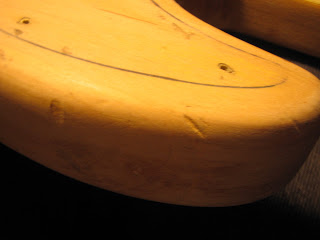
The dented areas are first generously wetted with water - let it soak in for a few minutes at least - and then rewet.
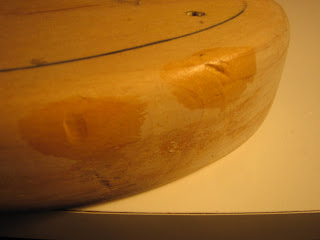
The a cotton cloth is dipped in water, and the wet part is applied over the dent. The tip of a hot soldering iron is pressed against the wet cloth and rolled around a bit. There should be plenty of steam as you do this - otherwise your soldering iron isn't hot enough or you don't have enough water.
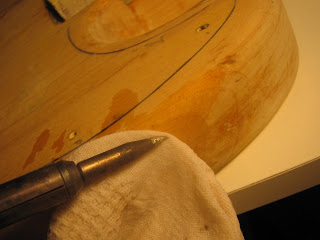
This process should be repeated until the dent has popped out - with lots of added water to the wood and cloth each time and allowing the soldering iron to heat up again. I steamed these dents about 4 times over a 10 minute period.
As you can see - the dents are still visible - but the have popped out til they are almost even with the surface. Once this body is sealed, primed and sanded they shouldn't be visible at all.
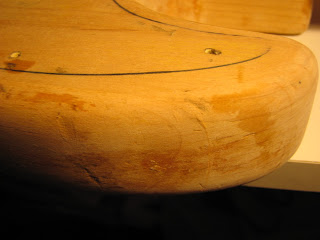
The second view better illustrates how the dents have been expanded out to near the original contours.
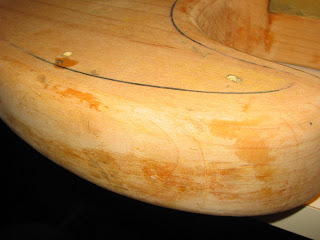
I've used this technique on alder, ash and mahogany bodies - I haven't tried it on a harder wood such as maple - it may not work because it may be hard for the moisture to penetrate the wood to get the required steaming action - but who knows, maybe it will work ?
- Maton 'phil Manning' Re-fret
I get a lot of enquiries about re-fretting - what's involved, how does it affect the guitar's sound and playability? So when this rather nice old Maton came in for a re fret I took the chance to take a few photos. This is not too good a picture...
- Transferring A Design From Paper To Wood: Using A Pounce Or Ponce Wheel & Powdered Charcoal
This is just a little how too article on a simple technique that comes in handy when working from a tracing of a guitar or part of a guitar, and transferring that tracing to the surface of the wood being used to build the new instrument. It involves...
- How To: Fender Mary Kaye Blonde Finish
The Mary Kaye finish is a slightly transparent blonde finish - much like Fender's blonde Telecaster finish but without any yellow tint (and very different from the more yellowed and more transparent butterscotch finish) - applied over ash wood and...
- 1990 Les Paul Junior Tv, Vintage Style Refinish
The Les Paul Junior TV finish is one of the classic vintage guitar finishes and also one of that has been re-interpreted in many ways on various reissues over the years. The worst interpretation in my opinion was Gibson's early 90's version,...
- 1965 Gibson Heritage Acoustic Top Refin
Unfortunately I didnt think to take an actual "before" picture of this instrument, but this guitar had been modified to play left handed with a new bridge, had gold Grover tuners installed, had the headstock stripped and unfortunately had the top stripped,...
Guitar
How To: Steaming out dents in guitar bodies
I wanted to write a post on a technique I've been using for about the last year to remove dings and dents in guitar bodies.
I want to emphasize that this only works for cases where the wood is simply compressed and it will not work for chips, where the wood is actually missing.
The idea is to get water into the dented, compressed wood and then heat it up with a soldering iron until steam is formed, which will then expand and swell out the compressed wood.
The example in this case is a 1966 Fender Jazz Bass body, made of alder. There are two dents I'm going to work on here - one is a sharp dent along the upper edge of the body and the other is a more rounded ding on the side. They are both plainly visible in the picture.
The dented areas are first generously wetted with water - let it soak in for a few minutes at least - and then rewet.
The a cotton cloth is dipped in water, and the wet part is applied over the dent. The tip of a hot soldering iron is pressed against the wet cloth and rolled around a bit. There should be plenty of steam as you do this - otherwise your soldering iron isn't hot enough or you don't have enough water.
This process should be repeated until the dent has popped out - with lots of added water to the wood and cloth each time and allowing the soldering iron to heat up again. I steamed these dents about 4 times over a 10 minute period.
As you can see - the dents are still visible - but the have popped out til they are almost even with the surface. Once this body is sealed, primed and sanded they shouldn't be visible at all.
The second view better illustrates how the dents have been expanded out to near the original contours.
I've used this technique on alder, ash and mahogany bodies - I haven't tried it on a harder wood such as maple - it may not work because it may be hard for the moisture to penetrate the wood to get the required steaming action - but who knows, maybe it will work ?
- Maton 'phil Manning' Re-fret
I get a lot of enquiries about re-fretting - what's involved, how does it affect the guitar's sound and playability? So when this rather nice old Maton came in for a re fret I took the chance to take a few photos. This is not too good a picture...
- Transferring A Design From Paper To Wood: Using A Pounce Or Ponce Wheel & Powdered Charcoal
This is just a little how too article on a simple technique that comes in handy when working from a tracing of a guitar or part of a guitar, and transferring that tracing to the surface of the wood being used to build the new instrument. It involves...
- How To: Fender Mary Kaye Blonde Finish
The Mary Kaye finish is a slightly transparent blonde finish - much like Fender's blonde Telecaster finish but without any yellow tint (and very different from the more yellowed and more transparent butterscotch finish) - applied over ash wood and...
- 1990 Les Paul Junior Tv, Vintage Style Refinish
The Les Paul Junior TV finish is one of the classic vintage guitar finishes and also one of that has been re-interpreted in many ways on various reissues over the years. The worst interpretation in my opinion was Gibson's early 90's version,...
- 1965 Gibson Heritage Acoustic Top Refin
Unfortunately I didnt think to take an actual "before" picture of this instrument, but this guitar had been modified to play left handed with a new bridge, had gold Grover tuners installed, had the headstock stripped and unfortunately had the top stripped,...
